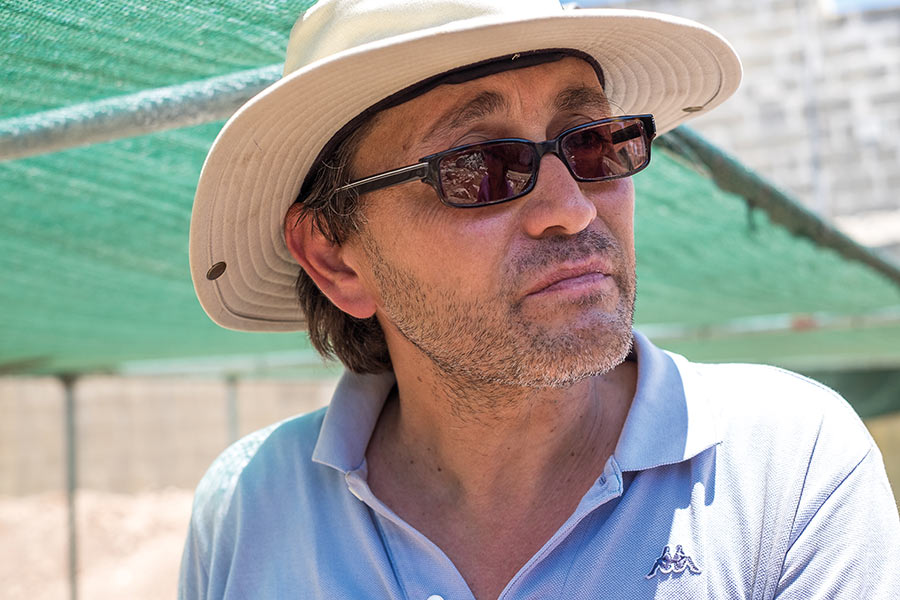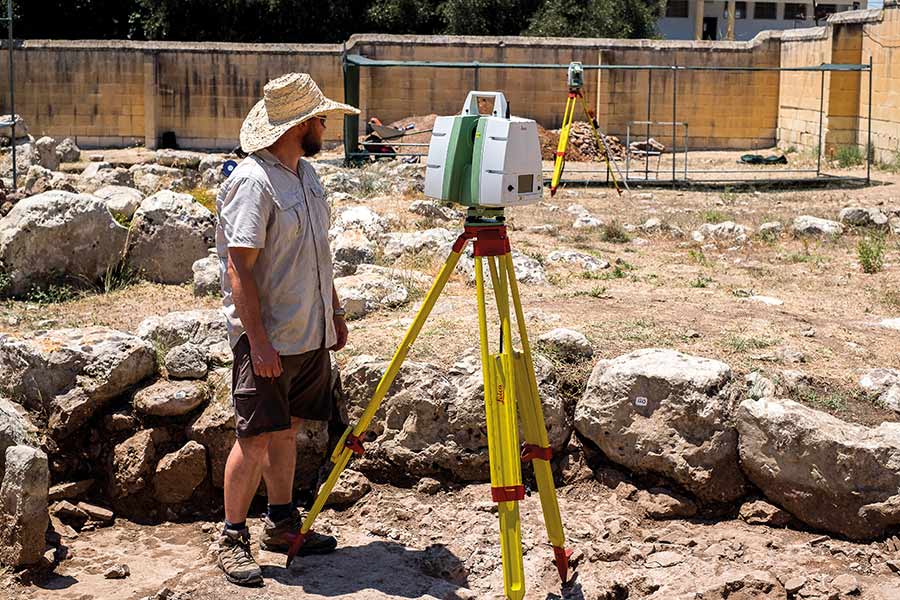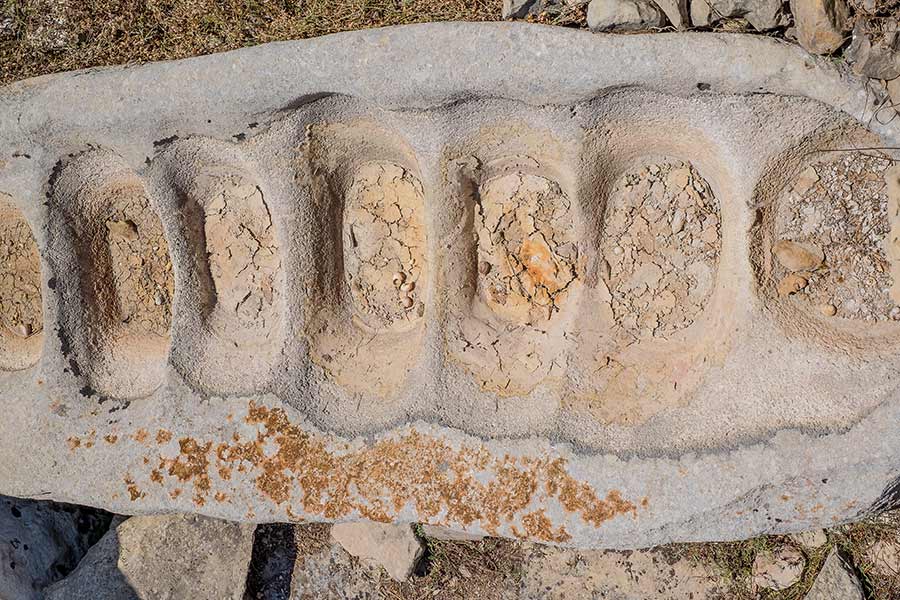Malta’s megaliths have attracted droves of archaeology and history enthusiasts over the years, all clamouring for the rich narrative our little rock has to offer. Shelby Marter talks to Prof. Nicholas Vella and his team as they dig up the past in Kordin and attempt to piece together long lost stories. Photography by Faisal Sadegh and Dr Edward Duca.

Humankind has a powerful inclination to preserve its stories for future generations. This has given rise to entire industries and technologies. From internet fora, to blogs and vlogs, to documentary filmmaking and so much more, we are ever keen to document and discuss our lives, our stories. But there was a time when all this was not possible, a time even before the written word, which has seen so many stories being lost. Now, a team of research fellows, graduate, and undergraduate students are working hard to get them back.
Dating as far back as 3600 bc, the Kordin Temples were dug up for the first time in 1909 by archaeologists Thomas Ashby and T. Eric Peet from the British School at Rome. Made up of three temple complexes, the find was unprecedented at the time. Now, 100 years later, Prof. Nicholas Vella (Department of Classics and Archaeology, Faculty of Arts, University of Malta) and his team are sifting through that soil again in order to gain insight into the prehistoric culture that built them, focusing on the only surviving complex currently under the care of Heritage Malta—Kordin III. Using a variety of approaches and research methods, they are seeking to give an understanding of what life was actually like in the Maltese Islands over 5,000 years ago. What was the temple’s role in the economy at the time? How did it shape the surrounding environment? The smallest of discoveries, a piece of pottery or a soil sample, could help answer these questions.
“For Prof. Nicholas Vella, this project is interesting because it allows him to pursue his research while also training his undergraduate students.”
| Meet the Researcher |
|
Dr Gianmarco Alberti At Kordin III, the archaeologists retrieved soil samples to allow specialists to reconstruct the natural environment of the area at the time the temples were in use. In order to put this evidence in context and to gain a long-term view of how the islanders modified their environment, Alberti has spent two years working with Grima and Vella to develop a logistic regression model in GIS to understand possible determinants of agricultural quality before heavy mechanisation. To do this, a sample of 1860s land-use maps of British Crown property in Malta was chosen. The model has highlighted how drastically the quality of the land, and its exploitation, can vary over small distances. Micro-environments and ecological niches are characteristic of Mediterranean islands, providing affordances which make it possible for human groups to thrive in otherwise inhospitable environments. The cultural responses to such challenges are richly documented in historic periods; for archaeologists these insights may allow questions to be posed for prehistory when evidence may be meagre. The results of the modelling may allow archaeologists to predict where evidence of earlier landscapes is likely to be located. Alberti has also created 3D visualisations of some of these maps. His work gave geographical references to around a hundred of them, through a painstaking and time-consuming GIS-based procedure. These were then digitised and fed into a geographic database he built; some of these maps were wrapped over a digital model of the terrain. Future students and researchers will be able to use these tools for their own research. Even more importantly, search tools can be used to data mine the maps. For example, researchers can retrieve the precise locations of nineteenth-century farmhouses in the study area, then compare these data with water availability and the type of crops grown, besides the existence of grazing grounds—an immeasurably useful tool. |
Digging Up the Past
Long days in the hot summer sun might not seem like the ideal way of spending their holidays for most undergraduates, but the opportunity to complete coursework by excavating a prehistoric
temple complex alongside specialised researchers has been an excellent opportunity for archaeology students from the University of Malta to put what they learn in class into practice. So far, the students have found bits of pottery, obsidian (volcanic glass), bone and painted plaster. These finds might not seem particularly exciting to the untrained eye, but as second-year archaeology student Gabriel Farrugia wisely remarks: Kordin III ‘must be seen within the whole context of the area.’ These finds will be able to tell us much more after they have been analysed with the appropriate scientific techniques that were unavailable at the time of the first dig.
Naturally, working alongside professional researchers is what makes this experience so valuable for students. Farrugia explains: ‘We learn from them, they teach us new techniques, new ideas, and it’s interesting to see how they look at prehistoric Malta.’ First year anthropology and archaeology student Gavin Borg comments: ‘Seeing different approaches to the discipline is rewarding.’ The variety of experience levels and research backgrounds united by this project enable undergraduates to become fully involved in the multidisciplinary approach necessary to discover the unwritten stories of the past.
Simplifying the Complex
Overseeing the undergraduate coursework and archaeological fieldwork at Kordin is Vella. For him, this project is interesting because it allows him to pursue his research while also training his undergraduate students. For several members of the team, this is the first time that they are working within the precincts of a prehistoric temple. Excited about the finds, he introduces many of the main features of the complex, and describes the significance of several temple design features.
The temple builders probably approached the site from what is called the forecourt, the area that sticks out of the two contiguous temple buildings. At Kordin, this feature is paved and creates a tiered level in front of the temple complex building, which Vella explains is quite significant because paved forecourts like this do not exist at other sites. This fact is an important detail, he says, ‘even the layout, the curve defining the outer limit is perfect.’
Across the forecourt are two temple entrances. To enter the main one to the left, one must mind a large step, or sill stone. Vella explains that the temple builders appear to have deliberately placed the sill in the doorway to emphasise that it is an entrance to an important place. Once inside, there is a feature unique to Kordin III: a stone block described in the original 1909 site report as a ‘boat shaped receptacle.’ This “boat” is made out of hard Coralline Limestone, which is different from the softer Globigerina Limestone used in the rest of the monument. It does not quite fit into position either, as if it was placed there at a later stage. Because of this, ‘it’s very clear it’s special,’ he notes.
“This is a rare opportunity to explore below the floors of a prehistoric temple structure.”
 Yet what does a prehistoric representation of a boat, or dugout canoe, tell us about this site? Vella notes how the site is relatively close to the sea. ‘We are at the head of a promontory that juts into the Grand Harbour. It would take us a few minutes to walk to the water’s edge, in Marsa. My colleague, Dr Reuben Grima (Department of Conservation
Yet what does a prehistoric representation of a boat, or dugout canoe, tell us about this site? Vella notes how the site is relatively close to the sea. ‘We are at the head of a promontory that juts into the Grand Harbour. It would take us a few minutes to walk to the water’s edge, in Marsa. My colleague, Dr Reuben Grima (Department of Conservation
and Built Heritage, Faculty for the Built Environment, University of Malta), who is supervising students on the other side of the site boundary wall, has suggested that the court area of the temple, where the stone “boat” is found, could represent the sea, one of two cosmological domains of importance to the prehistoric islanders,’ explains Prof. Vella. ‘When it rains, the court area gets flooded and the stone boat appears as though it is floating’ he remarks. Pointing in the direction of Sicily, he adds, ‘the sea facilitated mobility, would have brought the prehistoric islanders in contact with the world beyond the horizon, with raw materials not available locally, and other exotic objects.’ Whoever had access to this world, to its objects, its ideas, its knowledge traditions, must have had a special role in the society that built the temples. Other members of that society, including shepherds and farmers, will have been concerned with the other cosmological domain—the land—the source of food for humans and animals alike.
Soiling the Story
Most of the team is focused on examining temple structures and finding artefacts, yet perhaps the story of the temple people is not revealed by the artefacts in the soil, but instead by the soil itself. Prof. Caroline Malone, from Queen’s University Belfast leads the FRAGSUS project and is overseeing the analysis and recovery of soil samples being carried out by several specialists in an effort to understand what type of activity was taking place at the site while the temples were being used, and even perhaps before they were built. This is a rare opportunity to explore below the floors of a prehistoric temple structure, and to do so, the team is carefully digging up part of the stone paving slabs which sit over a thin layer of crushed limestone. Underneath, they have found dark soil deposit, signifying organic activity. Large samples of these deposits from the site are being taken back to the lab to be analysed. Searching this soil for organic remains such as shells, seeds, pollen, and animal bone might provide clues as to what the temple builders were eating, or perhaps feasting on. Focusing on the molluscs in particular is Dr Katrin Fenech (Department of Classics and Archaeology, Faculty of Arts, University of Malta) whose studies provide answers to the question of what impact humans have had on our environment. All this work, in combination with an understanding of the ecology of the time, will provide a fascinating glimpse into life in prehistoric Malta.
| Meet the Researcher |
Dr Katrin FenechFuelled by the potential unearthing of extinct or yet-to-be-discovered snail species, Fenech is working on sediment cores from all over the archipelago—Mgarr ix-Xini in Gozo, Xemxija, Wied Żembaq in Birżebbuġa and Marsa among others, in a bid to investigate the past environment and the impact humans may have had on it. Under Prof. Patrick J. Schembri’s (Department of Biology, Faculty of Science, University of Malta) and Vella’s supervision, and with the aid of radiocarbon dating, Fenech has made strides in putting together the puzzle our ancestors left behind. In fact it revisits many of the issues raised in a seminal article written thirty years ago by Prof. Anthony Bonanno (Department of Classics and Archaeology, Faculty of Arts, University of Malta) which looked at Malta’s prehistory from a socio-economic perspective. The Xemxija cores reveal that the environment prior to the arrival of the first food-producing settlers in the sixth millennium BC was open country, mainly grassland and karstland. There was also a body of freshwater, possibly even a small lake, in the area. Very interestingly, the study shows that Malta boasted woodland during the beginning of the Temple Period around 4000 BC and persisted into the Bronze Age, until around 1800 BC. At the same time, charcoal was only found in very small amounts, suggesting that there were no human fires set to clear any kind of vegetation. All this seems to lay to rest the long-standing theory that the first settlers found a forested environment and cleared the pristine vegetation to make space for agriculture. The environment was already open prior to the settlers’ arrival, meaning that erosion of land and vegetation changes happened due to climate changes and storm surges. |
Malone explains that the team is also finding animal bones from very young livestock, mostly lambs and piglets, in the deposits below the paving stones. Evidence from the first few samples of charred bone demonstrates that everything from these animals was boiled down for meat—nothing was wasted. However, Malone explains that the young animals were too small to justify for a decent meat payback, and may have been killed before the summer set in due to the lack of fodder available. Understanding the temple builders’ diet offers greater insight into the culture as a whole. ‘What you eat is who you are, in part. It distinguishes us. So food becomes a huge matter of cultural symbolism,’ Malone comments. This anthropogenic activity suggested by the dark soil, the pottery, and the human and animal rubbish has led the team to believe that the temple sites were probably special gathering places. ‘We don’t think they’re necessarily religious in the way we would see religious buildings today,’ Malone explains. The divide between sacred and profane that we envision in our modern society might have been looked upon very differently in the past.
“Whoever had access to this world, to its objects, its ideas, its knowledge traditions, must have had a special role in the society that built the temples.”
The finds are important, but the difficult part comes in organising the data. Malone explains: ‘The simple story here is that we have a multiphase temple structure and a creation of building upon building, layer upon layer.’ The time period that the first samples are providing are from a two-thousand-year span of history, so the team is trying to refine the data they are collecting to the earliest phase of temple development. ‘We are dealing with a range of time that was as old to the ancient Greeks as the ancient Greeks are to us,’ she says. The data is difficult to piece together, but by analysing dated information from the site in the hopes of linking soil samples to culture material to organic remains, the team can unravel the story of the temple builders. Malone notes: ‘We have so many questions, and yet, they’re very simple questions. They relate to trying to reconstruct the environment of the ancient temple builders, how that environment changed over time.’
Visualising the Past
With the project focused on scrutinising the role of the temples within prehistoric Maltese society, understanding environmental change on the islands is vital for visualising the context of the finds at this site. Jeremy Bennett, a Ph.D. student from Cambridge University is one of the researchers contributing to the project by helping the team scrutinise this environment in a high-tech way. He operates a Leica C-10 laser scanner that creates 3D visuals of the excavations the team is carrying out. This scanner, which takes over 260 camera images of the objects it is placed in front of, then calculates the distance of degree, and meshes the images together to create a 3D bubbled effect. The result is a vantage point from a 3D perspective that helps the team easily visualise the site or the recovered objects and easily save the scanned images to a flash drive.

This excavation at Kordin III was developed as a result of Fragility and Sustainability in Restricted Island Environments (FRAGSUS), a larger initiative made possible by the European Research Council, which is funding several excavations in Malta and Gozo over a five-year period. The overall goal of this programme is to gain insight into the lives of people who left no written records. As a result of FRAGSUS support, researchers from Queen’s University Belfast, the University of Cambridge, the University of Malta, the Superintendence of Cultural Heritage (Malta) and Heritage Malta are able to collaborate on this project. From experienced archaeologists to first year undergraduates, a variety of viewpoints and experience levels are helping put together this story.
‘Archaeology is inherently destructive,’ Bennett explains, because to collect valuable data, this team had to disturb the prehistoric floors. However, the 3D scans from this excavation might easily address post-excavation questions that arise, and preserve as much information as possible for future researchers, or even scholars within this same excavation project. Working in the FRAGSUS project, different researchers focus on varying details of the temple culture. Bennett is specifically studying terracing and agricultural change in Malta and Gozo, while others focus on the information provided by the human remains, the pollen from the soil samples, or the human story as a whole. Using drones and LiDAR data obtained from the Planning Authority, and building on Dr Gianmarco Alberti’s work (Department of Classics and Archaeology, Faculty of Arts, University of Malta), Bennett hopes to model the landscape changes over time to show the changing environment on the islands in the hope of connecting our modern views with the prehistoric landscape the temple culture would have experienced.
Piecing together a story as important as that of the temple builders takes multiple approaches and methods, and the insights of Jeremy Bennett, Prof. Caroline Malone, Prof. Nicholas Vella and the undergraduate archaeology students are only just a representation of the larger team this initiative encompasses. As a result, the dig at the Kordin temple complex is a true testament to the spirit of collaboration. Although the finds might at first glance appear unexciting, it certainly does not mean they are insignificant; every sample of soil, shard of pottery, or piece of animal bone connects the dots of a story that hasn’t been told for 5,000 years.





Comments are closed for this article!